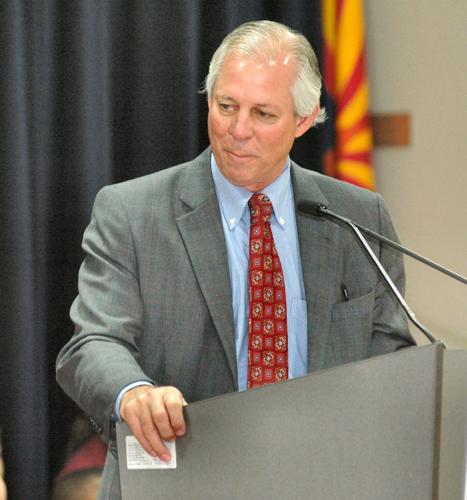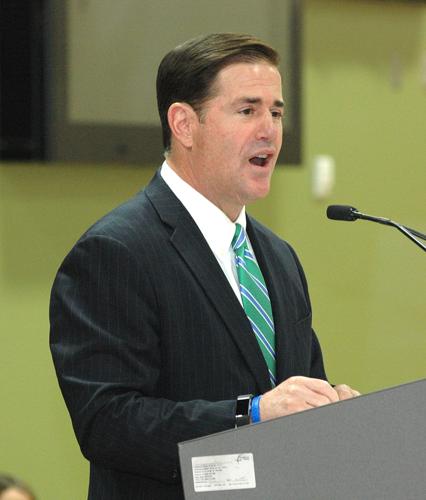More than 1,300 teaching positions in Arizona K-12 schools are still unfilled four weeks into the school year, according to a new report.
The survey released Tuesday by the Arizona School Personnel Administrators Association of 135 school districts and charter schools found that they began the year with more than 7,000 vacancies, meaning nearly one in five positions were unfilled.
The report comes as the state’s three universities formally introduced their “teacher academy” programs designed to provide free tuition for one or more years to those willing to go into the classroom.
Each of the universities has a slightly different approach, officials explained at a news conference Tuesday.
The University of Arizona works with those who have degrees in another field and want to go back and get a master’s degree in education. That concept was showcased by Clarisse White, who has a degree in political science but is now student-teaching high school government.
Northern Arizona University President Rita Cheng said her school is focused on a “grow your own” program, working with individuals in underserved communities to get them their teaching credentials while they continue to work at their old jobs.
And Arizona State University is providing mentoring support for graduates during their first year of teaching.
Gov. Doug Ducey, who proposed the program in January, said Tuesday he recognizes that putting more would-be teachers in the pipeline — the program provides free tuition to 200 — does not address the problem of keeping certified teachers in the profession.
More than 500 teachers have resigned so far this year, some simply by abandoning their positions and walking away, said Justin Wing, who conducted the new study for the administrators association.
Wing said most of the vacancies are being handled by long-term substitutes. But he said some of the gap was being made up by people teaching extra classes, with other schools either combining classes to the point where it exceeds the school’s class size limits or creating multi-grade classrooms.
Of the positions that schools did manage to fill, close to 2,500 were with people who do not meet the standard teaching requirements, with the largest share of those being people whose certification is pending.
But nearly 740 of these slots were filled by people with “emergency teaching certificates,” people who lack any actual training in how to teach but have some professional background in a subject like math or physics. And that has its own limits, with these certificates valid for one year and available only three times to any individual.
The Morrison Institute for Public Policy reported earlier this year that 42 percent of Arizona teachers hired in 2013 are no longer teaching in an Arizona public school. And more than a third of Arizona teachers have been in the classroom for four years or less.
“This is just one tool in the toolbox,” Ducey said of the newly launched “teacher academy” program. He cited other programs, including allowing people without teaching degrees to head classrooms.
“But we also know that student loan debt is an added challenge for many new teachers,” the governor said.
“Doctors, lawyers, business people, many will make six figures within a few years of graduation. But for teachers, paying off the debt from their education can take decades.”
In some cases, that debt “may push them out of the profession,” Ducey said.
UA President Robert Robbins, while citing the benefits of programs that pay for education degrees, said there’s another piece to the equation.
“My hope is that one day we will be able to pay the teachers that dedicate so much, and are so important to our society and our country, a better reward than they currently get financially,” he said.
The Morrision Institute study said elementary school teachers in Arizona are paid less than anywhere else in the country, even adjusting for costs of living. High school teachers fare little better, ranking 49th.
“I couldn’t agree more,” Ducey said when asked about Robbins’ comment. “This is why we put $168 million over and above inflation in last year’s budget.”
That includes $34 million for a 1.06 percent teacher pay raise, with a like amount promised for next school year. There’s also $37 million for “performance-based funding,” awarding additional dollars to high-performing schools. But only half of those new dollars are ongoing funding, with the rest being a one-time infusion, mostly for new school construction.
Ducey also cited the voter approval of Proposition 123, which will mean an additional $3.5 billion in state aid over a decade. But that was to settle a lawsuit filed by schools over the state’s failure in previous years to increase aid annually to match inflation, as required by law, with some estimates putting the bottom line at only about 70 percent of what the schools would have received had the law been followed.
State Schools Superintendent Diane Douglas wants to expand an existing 0.6-of-a-cent education sales tax to a full penny, raising an additional $400 million a year. Douglas said putting $300 million of that into salaries would translate into an average pay raise of $5,500.
The additional tax revenues, opposed by Ducey, would bring salaries close to the national average.
In proclaiming the benefits of the teacher academy concept, Ducey said he could not take credit for the idea. He said it actually came from Fred DuVal, his 2014 Democratic foe in the governor’s race, who suggested it during a debate they had in Tucson. DuVal was at Tuesday’s news conference at Ducey’s invitation.
“I think it shows this is not a political issue,” the governor said.






